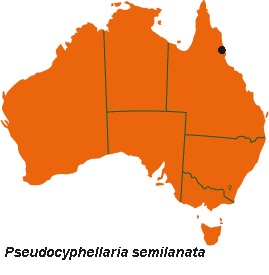



Australian Biological Resources Study
| Checklist of the Lichens of Australia and its Island Territories | ||
| Introduction | A–D | E–O | P–R | S–Z | Oceanic Islands | References | ||
| Pseudocyphellaria semilanata (Müll.Arg.) D.J.Galloway | ||
| Lichenologist 17: 306 (1985); Stictina semilanata Müll.Arg., Bot. Jahrb. Syst. 23: 293 (1897). T: Samoa, s. loc., Dr Reinecke; holo: G 002164. | ||
| Thallus irregularly spreading, loosely attached centrally, 8–12 (–15) cm wide. Lobes dichotomously branching, discrete from margins to centre or complex-imbricate centrally, 1–4 (–6) cm long, 4–10 mm wide, plane to ±canaliculate, rigid, rather coriaceous when dry, pliable when wet; apices divergent, furcate, ±ascending; lobe margins entire, ridged above and below, with tomentum from lower surface often projecting at right angles. Upper surface pale olivaceous to brownish when dry, dull slate-blue to glaucous green, suffused reddish brown when wet, undulate, shallowly ridged to distinctly punctate-impressed; without isidia, phyllidia or soredia. Maculae minute, white, imparting a delicate marbling to upper surface (×10 lens), prominent and ±reticulate at apices. Pseudocyphellae white, scattered, punctiform, 0.1–0.2 mm diam. Medulla white. Photobiont Nostoc. Lower surface yellowish white or pale buff at margins, darkening to red-brown centrally; tomentum very thick, woolly, whitish to red-brown or ±black. Pseudocyphellae white, scattered, round to irregular, 0.2–2 mm diam.; margins swollen, prominent, concolorous with lower surface, often sunken in tomentum. Apothecia marginal to submarginal, rarely laminal, sessile, 0.5–2 mm diam.; disc pale to dark red-brown, smooth, epruinose, sometimes with small central lobules of sterile tissue; exciple prominent in young fruits, slightly roughened to coarsely scabrid-verrucose, pale brownish; epithecium pale red-brown; hymenium colourless. Ascospores fusiform-ellipsoidal, 1–3-septate, (25–) 30.5–33 (–36) × 5.5–8 µm, pale yellow-brown to red-brown. CHEMISTRY: Methyl gyrophorate (±), gyrophoric acid (±), 7β-acetoxyhopane-22-ol, hopane-7β,22-diol (trace) and hopane 15α,22-diol. |  |
|
| Occurs in north-eastern Qld, on tree trunks in montane rainforest. Also from Indonesia to Samoa and Ogasawara-shotō (Bonin Is.) in the western Pacific. | ||
| Galloway et al. (2001) | ||
| Checklist Index |
| Introduction | A–D | E–O | P–R | S–Z | Oceanic Islands | References |
This work is copyright. Apart from any use as permitted under the Copyright Act 1968, no part may be reproduced by any process without prior written permission from Australian Biological Resources Study. Requests and inquiries concerning reproduction and rights should be addressed in the first instance to Dr P. McCarthy. These pages may not be displayed on, or downloaded to, any other server without the express permission of ABRS.